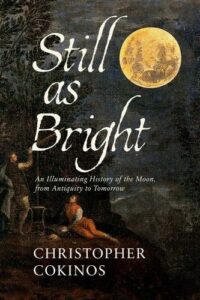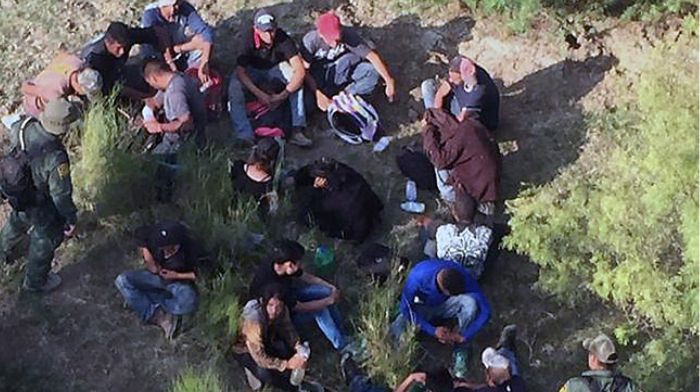In the mid-1890s, the Pall-Mall Gazette in England ran illustrations by Fred T. Jane in a series called “Guesses at Futurity,” which were visual speculations on life in the year 2000. Number 7 was “Interplanetary Communication. Gold Mining on the Moon.” A partially buried and shaded glass tunnel ran from the foreground past two lampposts and into a complex of enclosed bridges and towers. Above the usual craggy peaks, there hung a half-Earth and an oblong satellite that bristled with antennae. While the architecture is more late Victorian than twenty-first century, the reason for the base—mining—is closer to the mark. Instead of gold, today it’s the water.
We’re following the water, not only as an economic but as a scientific gift. Lunar water ice preserves a chemical genealogy dating back to the formation of the solar system. Such knowledge will help guide our search for life elsewhere. Ancient cometary ice can further our ability to understand the nature of the outer solar system, and the composition of other lunar materials will help refine our models of the Moon’s formation and structure.
The far side of the Moon beckons as a site for radio telescopes. Shielded from the noisy Earth, the far side could be an ideal place to study everything from the magnetic fields of exoplanets to signatures of the early universe. Others dream of infrared telescopes located in dark polar craters, instruments so sensitive that they could detect seasons and weather on worlds around other stars.
If we are to live on other worlds, we must borrow from and care for this one.
The place astronauts will call home will have to protect and comfort them. The Moon’s surface is beset by sweeping sheets of radiation, from the Sun and other stars, even other galaxies, near-light-speed particles that slice through unprotected viscera, cutting DNA molecules like rice paper and leading, eventually, to cancerous mutations. Long-term lunar dwellers also could suffer from the lingering effects of extended exposure to one-sixth gravity.
Moondust is a huge problem. Apollo astronauts were vexed by the sharp-edged powder, which got under their fingernails and into their noses, lungs, mouths, and eyes. Apollo 12’s Alan Bean said residual dust in the LM cabin “made breathing without the helmet difficult, and enough particles were present… to affect our vision.” The stuff is like “silty sand… [but] sharp and glassy,” according to the Lunar Sourcebook. Coughing and itching are nuisances, but simulated long-term exposure, in one study’s words, revealed “significant cell toxicity in neuronal and lung cell lines in culture, as well as DNA damage.” Mitigating the dust is a significant challenge, but astronauts and their equipment could be protected with invisible electrodes that activate what researcher Carlos Calle calls an “Electrodynamic Dust Shield”—shifting electric fields that keep the dust from sticking to a surface.
Located at the south polar region, a lunar community would have access to nearly perpetual sunlight for power but might have to bury buildings in regolith for radiation and micro-meteorite protection. Companies like ICON are experimenting with 3D printing of heated lunar regolith. Japanese researchers are considering a trial-run lunar “base” populated first by robots. It might not be a bad idea. Questions abound about the ease of working with lunar compounds, including how to extract oxygen directly from the regolith. None of this has yet been demonstrated on the Moon. It probably will be harder than we imagine.
A more permanent settlement might take us back to our first homes: caves. Altamira 2.0. Although many lunar rilles are collapsed lava tubes, there are others whose roofs remain. Housekeeping in a lunar lava tube removes much of the risk of surface habitation: You are protected from micrometeorites, radiation, temperature swings, and surface dust. Some lava tubes have partly collapsed roofs—skylights—that can function as entry points.
Researchers have provisionally identified nearly a dozen lava tubes, including one in the Marius Hills that goes on for miles and miles. There seems to be a system of connected lava tubes near the crater Mairan. These are, unfortunately, quite far from the lunar south pole region where precious water ice waits. Yet some tubes could have ice in them too. No one knows for sure.
Wherever they are on the Moon, astronauts will find that the only elbow room will be in a spacesuit. Science-fiction dreams of capacious domed crater cities must wait. The living space will be tight. And small groups in confined spaces inevitably experience poor sleep, along with stress that can lead to moodiness, tempers, anxiety, mild to severe depression, even decreased dexterity. Which suggests that lunar denizens would benefit from something that both monks and researchers have demonstrated is helpful: mindfulness.
Defined as consciously focused, nonjudgmental awareness of the present, mindfulness can be cultivated through everything from three-minute breathing exercises to years of meditation. Studies on mindfulness-based practices among astronauts are relatively scarce, but psychologist Francesco Pagnini is changing that. A researcher at Milan’s Catholic University of the Sacred Heart and an associate researcher at Harvard University, Pagnini tells me that while NASA isn’t formally incorporating mindfulness or meditation into astronaut training—not yet, anyway—there is of course consensus that promoting well-being is foundational. Some astronauts do in fact already practice mindfulness.
Though the astronaut corps is a far cry from the test-pilot machismo of the early Space Age, Pagnini explains that that space travelers are still loath to admit to boredom or stress. Doing so could endanger their flight status. Still, he thinks that mindfulness, meditation, and relaxation exercises will be part of training within a few years. It’s no longer about just toughing out a mission. “Now we talk about thriving [in] space,” he says.
To that end, Candice Alfano, a University of Houston psychologist, has found that overwintering residents of Antarctica benefit from “savoring.” This can include things that dwellers in isolated communities have relied on for eons: song, dance, rituals, and festivities. To sustain that in space environments, mission planners need to allow astronauts something they are typically reluctant to offer: spare time.
Famously, Apollo 7 commander Wally Schirra defied Mission Control when that flight’s schedule became impossible to manage. Skylab astronauts did the same. It’s better now, but there will be enormous pressure on the Artemis astronauts, even on longer missions, to fill every moment with tasks. Mission planners need to respect the emotional need for savoring. It can also have a practical benefit: it could make astronauts better able to communicate their experiences creatively and authentically while in the moment for those of us on Earth.
Then there’s the green world. In 2015 and 2016, Scott Kelly grew the first flowers in space—zinnias—and the photographs he took of them rival those of the James Webb Space Telescope for their beauty. Like other astronauts conducting experiments with plants, Kelly became absorbed by the sprouts, the leaves, the blossoms. Before astronauts dine on a few lettuce leaves grown in hydroponic racks, they eat up the views, smells, and textures of these reminders of the Earth.
Recently, researchers at the University of Florida did something no one has ever done before: They grew plants in alien “soil.” Using actual lunar regolith collected during Apollo, scientists Anna-Lisa Paul and Robert Ferl successfully raised Arabidopsis thaliana, a delicate cress with tiny green leaves. Although the lunar-soil cress plants did not grow as vibrantly as the control group, the fact that they grew at all left Paul, in her words, “astonished.” There, in the photos, are green leaves birthed from dark, Moony stuff. Someday, we’ll be watering cress planted in Moon dirt with melted Moon water.
By needs we take the green world with us. Not just for salads but for psyches. The green world, the sunflower forest, savannahs, jungles, riverbanks—this is where we came of age as intelligent primates. Green feeds our being, not just with calories but with meaning. It softens the metal edges. Cover a lunar lava tube, seal it, pressurize it, melt some local ice: we could have gardens running riot in tunnels on the Moon, vines gripping basalt, Pickering’s revenge.
If the Moon proves to be a place we can live and work, some of our worst tendencies may reappear.
Can we grow enough on the Moon to lessen or even eliminate terrestrial supplies? A team of Chinese researchers survived on their own for two hundred days in a sealed habitat, raising crops, recycling water and waste all while producing breathable air. At the University of Arizona, the Controlled Environment Agriculture Center features the Lunar-Mars Greenhouses, corridors in which hydroponic sweet potatoes grow wildly—much of the plant is edible, a good choice for space. It’s also viny and green—welcome sight for nature-starved humans.
Such space farms will provide calories, recycle water, and breathe out oxygen. Researchers are looking at how fish and algae can be raised and harvested in space; both are sources of protein and provide recycling capacities. There’s even talk of genetically engineering space food (including protein-rich insects) with the radiation- and-desiccation fighting DNA of hardy microscopic tardigrades. Insects may be more than protein: a Korean study found that caring for crickets improves mood and affect.
We need green on the gray Moon—violas, prickly pear, millet—because if we are to live on other worlds, we must borrow from and care for this one. What the poet Dylan Thomas called “the force that through the green fuse drives the flower” can charge our ethics as we learn to live more carefully.
In 1961, Philadelphia’s Fels Planetarium director I. M. Levitt had a “Moon Room” constructed to show visitors how we’d live there in the future. The circular Moon Room—made of molded plastic—featured all the comforts of home: TV, recliner, built-in desk, an ultraviolet lamp for simulated sunlight and more. Comfortable enough! Giving the astronauts as much agency as possible in designing everything from their sleeping pods to utensils will be important in the Moon Rooms to come.
Skylab astronauts, for example, loathed how small their mealtime utensils were. (Industrial designer Raymond Loewy was a pioneer in helping NASA see that creature comforts were necessary for Skylab’s astronauts, our first long-duration space residents. Loewy convinced NASA that Skylab needed color schemes, muffled circulation fans, and, against engineers’ wishes, windows.) The International Space Station has come a long way since.
“In all of the excitement surrounding the prospect of human settlement of the Moon,” writes philosopher JS Johnson-Schwartz, “it is easy to forget that it will be incredibly difficult for humans to eke out an existence there… lunar settlers will have to devote a considerable portion of their energies to the provision and distribution of the basic necessities of life.” In the long run, if the Moon proves to be a place we can live and work, some of our worst tendencies may reappear and this needs to be acknowledged and minimized. Johnson-Schwartz cautions,
Whoever is tasked with overseeing life support production and distribution systems might succumb to the temptation to use their position to extort others by controlling the flow of breathable air or consumable water. Privacy may be virtually nonexistent…And the need to maintain a population that is both large enough to sustain the settlement but not so large it strains life support systems will place possibly unwelcome bounds on the reproductive autonomy of settlers.
Lunar humans—lumans?—will demand, design, and deploy community standards and facilities that will make habitats into homes and homes into communities. Johnson-Schwartz also sees the opportunities in talking about these issues now: “We should set the bar high instead of low when it comes to offering lunar settlers lives that are worth living.”
It is a long trek from an Artemis Base Camp to “the first lunar state,” but we have the opportunity to map such a trek now. The ultimate lunar spin-off technology might not be low-impact mining of rare Earth elements. It might not be hydrogen rocket plants for ships bound to Mars and the Asteroid Belt. It might be the yet-perfected art of solving problems without creating new ones. It’s a task as tall as the mountains of the Moon.
__________________________________

From Still as Bright: An Illuminating History of the Moon, from Antiquity to Tomorrow by Christopher Cokinos. Copyright © 2024. Available from Pegasus Books.
























































